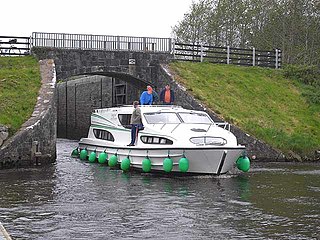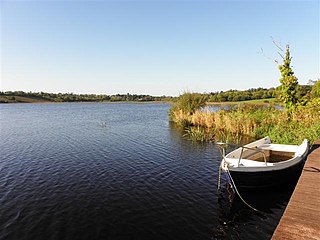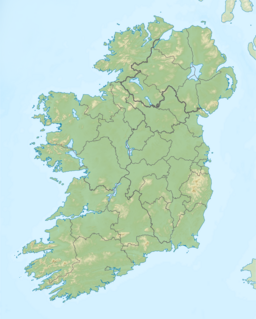
Keshcarrigan is a village in County Leitrim, Ireland. It is situated on the Shannon-Erne Waterway and R209 road and under Sheebeg, an ancient pagan burial site which overlooks Lough Scur to the north and Keshcarrigan Lough to the south. Keshcarrigan features in the writing of the novelist John McGahern who lived nearby.
Fenagh is a village in the south-east of County Leitrim in Ireland. It is 4.8 kilometres south-west of Ballinamore and 12 kilometres (7 mi) north of Mohill, the village being on the R202 road. The village is in a civil parish of the same name. Fenagh is located in the eastern 'spur' of the Barony of Leitrim.

Lough Melvin is a lake in the northwest of the island of Ireland on the border between County Leitrim and County Fermanagh. It is internationally renowned for its unique range of plants and animals.

The Shannon–Erne Waterway is a canal linking the River Shannon in the Republic of Ireland with the River Erne in Northern Ireland. Managed by Waterways Ireland, the canal is 63 km (39 mi) in length, has sixteen locks and runs from Leitrim village in County Leitrim to Upper Lough Erne in County Fermanagh.

Kiltubrid or Kiltubbrid is a civil parish in the barony of Leitrim, County Leitrim, Ireland. The villages of Keshcarrigan and Drumcong lie within the civil parish.

Ardcarn or Ardcarne is a civil parish in County Roscommon, Ireland, 8 km north-west of Carrick-on-Shannon.

The Muintir Eolais of Conmaicne Réin were nobles of Gaelic Ireland. For seven hundred years from the 8th century, they lived in and ruled an area roughly conterminous with present-day south County Leitrim. Their territory comprised the lands named Maigh Nissi and Maigh Rein, today the baronies of Leitrim and Mohill respectively.

Glencar Lough, locally known as Glencar Lake, is a freshwater lake in the northwest of Ireland. It covers an area of 1.15 square kilometres and lies mostly in County Leitrim with a smaller part in County Sligo. Glencar Waterfall is located near the lake's north shore on the Leitrim side.

Glenade Lough, locally known as Glenade Lake, is a freshwater lake in the northwest of Ireland. It is located in north County Leitrim in the Glenade Valley.

Garadice Lough (Irish: Loch Guth Ard Deas, also known as Garadice Lake or Lough Garadice, is a freshwater lake in County Leitrim, Ireland. It is located in the south of the county and now forms part of the Shannon–Erne Waterway.

Lough Scur is a freshwater lake in south County Leitrim, northwest Ireland. It is part of the Shannon–Erne Waterway. There have been Human settlements here since the New Stone Age. Modern features include quays and moorings. Protected features are Castle John, three Crannogs, and the causeway into Rusheen Island, though "Jail Island" is not protected. The ecology of Lough Scur, and indeed all county Leitrim lakes, is threatened by pollution and invasive species such as curly waterweed, zebra mussel, and freshwater clam.
St. John's Lough, also known as St. John's Lake, is an irregularly shaped freshwater lake located in south County Leitrim, in northwest of Ireland. The lake forms part of the wider Shannon–Erne Waterway tourist attraction. The ecology of John's Lough, and the Shannon-system, is threatened by pollution and invasive species such as curly waterweed, zebra mussel, and freshwater clam.

Rinn Lough, also known as Lough Rynn, is a freshwater lake in the northwest of Ireland. It is located in south County Leitrim.
Nisi Mac Niata lived in 6th century Gaelic Ireland. Nothing is known of his life, but his death left a legacy for a millennium. Namely, the Túath where he died was renamed in his honour, and his brother Saint Caillín obtained a substantial honour price in compensation under Brehon Law, securing a revenue stream for the famous monastery of Fenagh.

The Keshcarrigan Bowl is an Iron Age bronze bowl discovered to the north of Keshcarrigan, County Leitrim, Ireland, in the 19th century. The bowl was found in the waterway between Lough Scur and Lough Marrave. It was perhaps a ceremonial drinking cup. The bowl would have been a prestigious item in 1st century Ireland, the bird-shaped handle outstandingly designed and skillfully executed. The Keshcarrigan Bowl is in the archaeology branch of the National Museum of Ireland.
Carrickaport lough is a freshwater lake in Kiltubrid parish, south County Leitrim, Ireland. Drumcong village, and Lough Scur, lie nearby. Carrickaport lough is known for quality bream and pike fishing. The ecology of Carrickaport lough, and other county waterways, is threatened by curly waterweed, zebra mussel, and freshwater clam invasive species.
Keshcarrigan Lough is a mesotrophic freshwater lake near Keshcarrigan in County Leitrim, Ireland. Known for quality coarse fishing, the lake allows bank fishing from concrete stands on the northern shore, two with wheelchair access. The ecology of Keshcarrigan Lough, and other county waterways, is threatened by curly waterweed, zebra mussel, and freshwater clam invasive species.

Castlefore Lough is a mesotrophic freshwater lake in County Leitrim, Ireland. Known for good coarse fishing, the lake has limited bank fishing. The ecology of Castlefore Lough, and other county waterways, is threatened by curly waterweed, zebra mussel, and freshwater clam invasive species.
Drumaleague Lough is a very small freshwater lake in County Leitrim, Ireland. The ecology of Drumaleague Lough, and other county waterways, remains threatened by zebra mussel and other invasive species.
Lough Conway is a very small freshwater lake in northwest Ireland.













